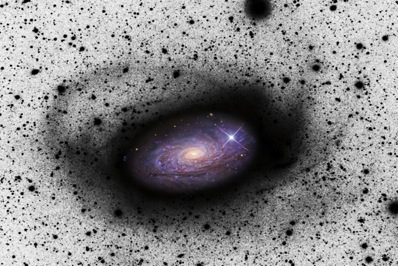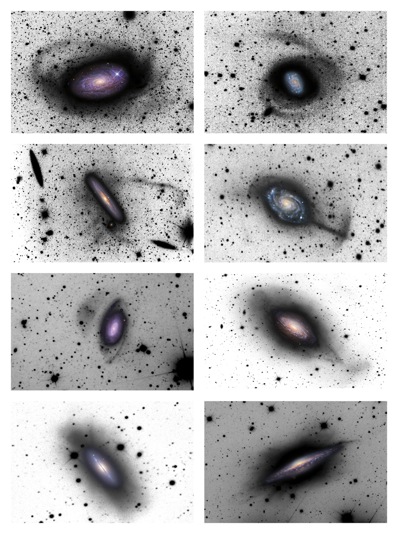


|

|
 |
|
Spiral galaxies grow by swallowing dwarfs by Nicky Guttridge for ASTRONOMY NOW Posted: 09 September 2010 A new survey, based on deep-field observations of spiral and dwarf galaxies, has provided a deeper insight into the growth of spiral galaxies.  Stellar streams around the galaxy M63: remnants of a satellite galaxy that M63 has swallowed. The central part is an ordinary positive image; in the outer regions, the negative of the image is shown. Image: R Jay GaBany (Blackbird Observatory, www.cosmotography.com) in collaboration with David Martinez–Delgado. The pilot survey was conducted using three privately owned observatories in the USA and Australia. These telescopes were also equipped with CCD cameras, and could be operated remotely. For the first time, the observations reach beyond our immediate cosmic neighbourhood – known as the “Local Group” of galaxies and reveal structures surrounding galaxies that are associated with galactic merging and growth. Spiral galaxies grow by swallowing smaller dwarf galaxies that pass close to them. The larger galaxy’s gravitational pull severely deforms the smaller star system, distorting its shape. Over the course of several billion years, this influence causes structures to form between the two galaxies, such as tendrils and stellar streams. These structures can then be detected through sensitive observation. One common outcome is for the smaller galaxy to be transformed into a “tidal stream” of stars that, following additional billions of years, will be completely assimilated into the spiral galaxy. This new study shows that stellar streams with masses of up to five percent of the galaxy’s total mass are quite common in spiral galaxies.  Examples for traces of spirals swallowing dwarf galaxies, as found with the new survey. For all images, the central part is an ordinary positive image. In the outer regions, the negative of the image is shown. Wisps, plumes, stellar streams, and partially disrupted satellites or stellar cloud indicate merger processes. Image: D. Martínez-Delgado (MPIA and IAC), R. Jay Gabany (Blackbird Obs.), K. Crawford (Rancho del Sol Obs.) et al. However, to investigate how the theoretical predictions of the frequency of such digestive processes match observational evidence, a larger sample of galaxies is needed. This new research, led by astronomer David Martínez-Delgado of the German Max Planck Institute for Astronomy and the Instituto de Astrofisica de Canarias in Spain, detects signs of galaxies merging at distances of up to 50 million light-years from Earth. Theoretical models concerning the evolution of spiral and dwarf galaxies predict the presence of various structures in the galactic disc that are distinct indications of mergers, such as giant debris clouds. This latest research shows all these previously predicted features to be present, lending weight to existing evolution theories. The full research paper will be published in the Astronomical Journal. Next, Delgado and the team of researchers intend to perform more quantitative tests to see whether the models are accurate at predicting the relative frequency of the different morphological features. |
|
|
|
|